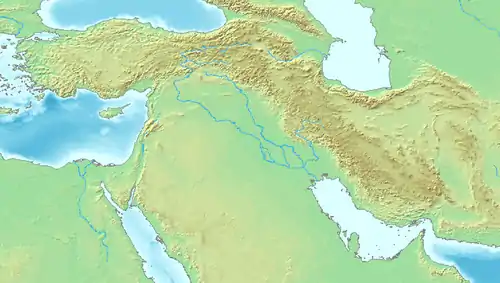Nin-kisalsi
Nin-kisalsi (Sumerian: 𒎏𒆦𒋛) was a Sumerian ruler of the Mesopotamian city of Adab in the mid-3rd millennium BCE, probably circa 2600 BCE.[1]
| Nin-kisalsi 𒎏𒆦𒋛 | |
|---|---|
 Headless votive statue, from Adab, Iraq, early dynastic period. Museum of the Ancient Orient, Istanbul | |
| Reign | 26th century BCE |
| Dynasty | Dynasty of Adab |
| Religion | Sumerian religion |
His name does not appear in the Sumerian King List, but he is known from one inscription bearing his name. The inscription, on a bowl fragment, reads:
𒈨𒁲 𒈗𒆧𒆠/ 𒂍𒊬 𒁓 𒈬𒄄 / 𒎏𒆦𒋛} 𒑐𒋼𒋛 𒌓𒉣
me-silim lugal kisz e2-sar bur mu-gi4 nin-KISAL-si ensix(GAR.PA.TE.SI) adab
"Me-silim, king of Kish, to the Esar temple sent over (this) bowl (for the burgi ritual). Nin-KISALsi, (was) the governor of Adab."— Inscription of Mesilim mentioning Nin-Kisalsi[2]
It appears from this inscription that King Mesilim of Kish was contemporary with Nin-kisalsi and probably his suzerain.[3] Another such ruler is Lugalshaengur, Governor of Lagash, who also appears in inscriptions as a vassal of Mesilim.[4][3]
References
- Bertman, Stephen (2005). Handbook to Life in Ancient Mesopotamia. OUP USA. p. 92. ISBN 978-0-19-518364-1.
- "CDLI-Archival View". cdli.ucla.edu.
- Visicato, Giuseppe; Alberti, Amedeo; asiatici, Amedeo (1994). Early dynastic administrative tablets of Šuruppak. Istituto universitario orientale. pp. 15–19.
- Delougaz, P. (1960). "Architectural Representations on Steatite Vases". Iraq. 22: 90–95. doi:10.2307/4199671. ISSN 0021-0889. JSTOR 4199671.
